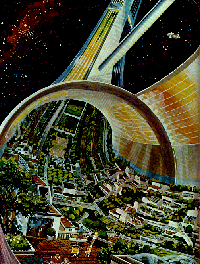L5 Society

The L5 Society is an organization formed in 1975 to promote the space colony concepts of Gerard K. O'Neill. It merged with the National Space Institute in 1987 to form the National Space Society. The inspiration for the L5 Society came from O'Neill's first published paper on the subject, "The Colonization of Space."1 This influenced a number of people who later became leaders of the Society, including Keith Henson, a young entrepreneurial engineer and his wife Carolyn, of Tucson, Arizona. The Hensons corresponded with O'Neill and were invited to present a paper on "Closed Ecosystems of High Agricultural Yield" at the 1975 Princeton Conference on Space Manufacturing Facilities, organized by O'Neill. A sign-up sheet at the conference eventually made its way to the Hensons, who also obtained O'Neill's mailing list. The Hensons incorporated the L5 Society in August 1975, and sent its first newsletter to those two lists. The Society was founded partly because of Arizona Congressman Morris Udall, who at the time was a serious candidate for American President. Carolyn Henson arranged a meeting between O'Neill and Udall from which Udall emerged enthusiastic about the idea. The first issue of the L5 News, published in September 1975, included a letter of support from Udall and the rallying cry that "our clearly stated long range goal will be to disband the Society in a mass meeting at L5."
Public excitement over the L5 scenario peaked in about 1977, the year in which NASA conducted its third consecutive summer study on Space Settlements and Industrialization Using Nonterrestrial Materials. In this study, physicist and L5 director J. Peter Vajk and others developed the most detailed scenario yet for production of solar power satellites (SPSs) from lunar materials. The scenario called for a space manufacturing facility that would house 3,000 workers in a rotating facility constructed from refurbished Shuttle external tanks. The study identified how many launches of the Shuttle and a Shuttle-derived heavy-lift vehicle would be required, and concluded that the project could have begun in 1985 and have three SPSs online by 1992. Unfortunately, two assumptions were made that later proved overly optimistic: the Shuttle would significantly reduce the cost of space launch, and it would fly 60 times per year. However, the scenario did serve as a significant proof of concept. Also in 1977 two major books came out on the subject, O'Neill's The High Frontier and T. A. Heppenheimer's Colonies in Space, bringing in a new wave of members.
The L5 Society opposed the United Nations Moon Treaty in 1979–1980 on the grounds that the "common heritage" provision of the Treaty would stifle development of nonterrestrial resources, crucial to the construction of an O'Neill-type colony. The Society hired Washington lobbyist and lawyer Leigh Ratiner to train a number of L5 activists on the art of winning political support. This proved successful: the Senate Foreign Relations Committee was persuaded to oppose the Treaty which consequently was never signed by the United States. However, the L5 Society fared less well in its battle over solar power satellite funding. The Department of Energy had spent about $25 million on SPS research from 1977 to 1980, but the Carter administration eliminated the $5.5 million for SPS that was originally in the budget for fiscal year 1981. L5 director Mark Hopkins, who later formed Spacecause and Spacepac, lobbied intensively but unsuccessfully to get Congress to restore funding for SPS. With the loss of this program died the dream of realizing an L5 colony anytime in the foreseeable future.
Reference
1. O'Neill, G. K. "The Colonization of Space." Physics Today 27 (September 1974): 32–40.


